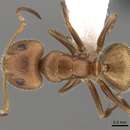en
names in breadcrumbs


This is a relatively uncommon species. It occurs in lowland wet forest habitats. It has been collected several times in canopy fogging samples at La Selva Biological Station. At Llorona, in Corcovado National Park, I found a nest in an old banana patch along beach. The nest was in a hollow twig, 2m high, inside diameter 4.5mm, outside diameter 7mm.
At Puerto Viejo de Limon, in beach strand vegetation, I found a few workers in a small dead stick. Curiously, the workers ran with Azteca workers in the vicinity and blended in with them. Similarly, at San Pedrillo station in Corcovado National Park, I found C. pittieri and Azteca workers running together on Passiflora pittieri shoots, visiting extrafloral nectaries. Does this species have a special relationship with Azteca?
Caribbean, Costa Rica, south to Brazil, Peru (Bill Mackay, pers. comm.). Costa Rica: Atlantic and southern Pacific lowlands.
Extant: 2 valid subspecies
Camponotus (Myrmobrachys) pittieri Forel, 1899i PDF: 143 (s.w.) COSTA RICA. Neotropic. AntCat AntWiki HOLTaxonomic history
Combination in Camponotus (Myrmobrachys): Forel, 1914a PDF: 271.